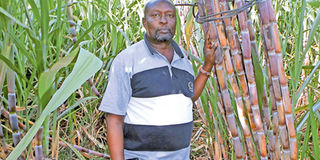Lecturer finds wealth in farming sugar cane, making juice from it

Dr Kennedy Ongaro displays sugarcane he grows at his home in Ngara. He uses the cane to make juice. PHOTO | PETER CHANGTOEK | NMG
What you need to know:
- In about a year, Ongaro had started harvesting the cane but could not consume all of it at home. The idea of making cane juice, therefore, came to mind.
- To start his cane business, he imported three sugar cane processing machines from Vietnam at Sh500,000 each.
- According to the don who teaches dynamics of leadership, social change, ethical practices in monitoring and evaluation, monitoring and evaluation in human rights and advocacy, and introduction to community development, one stem of cane produces one to two litres of juice, depending on its size.
- According to the Department of Nutrition in the Ministry of Health, consumption of raw sugar cane juice provides calories and carbohydrates to give one energy. The nutrients are even higher when the plant has not undergone any processing.
Driving along Thika superhighway at Ol Donyo Sabuk some five years ago, Dr Kennedy Ongaro stopped at a petrol station to fuel his car and bought some cane from a woman selling the produce.
Out of curiosity, he asked the woman to give him some cuttings so that he could try planting.
Ongaro, 51, the Dean, School of Human and Social Sciences at Daystar University, recounts he took the seven cuttings to his home in Ngara, Nairobi, and planted them in his sizeable kitchen garden.
“What inspired me most is that where I come from in Kisii, we farm plenty of sugar cane. I said why not farm it in Nairobi,” he says, adding he got more stalks and planted them in an open field in the neighbourhood bringing the total size of the farm to over quarter acre.
In about a year, Ongaro had started harvesting the cane but could not consume all of it at home. The idea of making cane juice, therefore, came to mind.
The cane, he says, cannot do well in arid and semi-arid areas, but grows in places such as Limuru, Kisii, Narok, Nyamira and Nyanza.
To start his cane business, he imported three sugar cane processing machines from Vietnam at Sh500,000 each.
“I brought three machines - one to train the youth in Kisii, another one to train people in Ngara, and the other one for use at my business,” he says.
He opened a juice bar in Kamakis at the Ruiru bypass which his wife currently operates.
To make the juice, he first harvests the cane from his farm and chops the stems into pieces.
Thereafter, he removes the outer layer and then washes the pieces and squeezes them in the machine alongside lemon, ginger as well as aloe vera or lemon grass, depending on the customers’ needs.
JUICE PRODUCTION
“I buy ginger and lemon from Marikiti and I have contracted someone who supplies me aloe vera,” he offers.
Ongaro reveals that in a good day, they produce up to 25 litres, with a litre going for Sh400. The same cane would go for Sh30 if sold raw.

Dr Ongaro squeezes juice from the sugarcane (left) and on the right, the juice that he produces in his enterprise. PHOTO | PETER CHANGTOEK | NMG
According to the don who teaches dynamics of leadership, social change, ethical practices in monitoring and evaluation, monitoring and evaluation in human rights and advocacy, and introduction to community development, one stem of cane produces one to two litres of juice, depending on its size.
“Some unscrupulous people add water to the juice, but that should not be the case. That’s why it is advisable to produce it when the customer is waiting or even watching,” says Ongaro, adding that he has a farm in Kajiado where he intends to plant cane and grapes to expand his start up and train the youth on juice production.
Sugar cane juice, according to him, changes its colour in a short time because it is alkaline.
“The alkaline does not allow it to remain fresh for long. For good juice, it must be produced at the place of consumption.”
According to the Department of Nutrition in the Ministry of Health, consumption of raw sugar cane juice provides calories and carbohydrates to give one energy. The nutrients are even higher when the plant has not undergone any processing.
“Sugar cane contains iron and vitamins such as A, C, B1, B2, B3, B5 and B6. But people should blend with other ingredients like lemon to add nutritional value and taste,’’ says Agnes Mwendwa, a nutritionist, adding that the juice contains potassium which aids in digestion.
The nutritionist warns that those with diabetes type 2 should not consumer it in large quantities.





